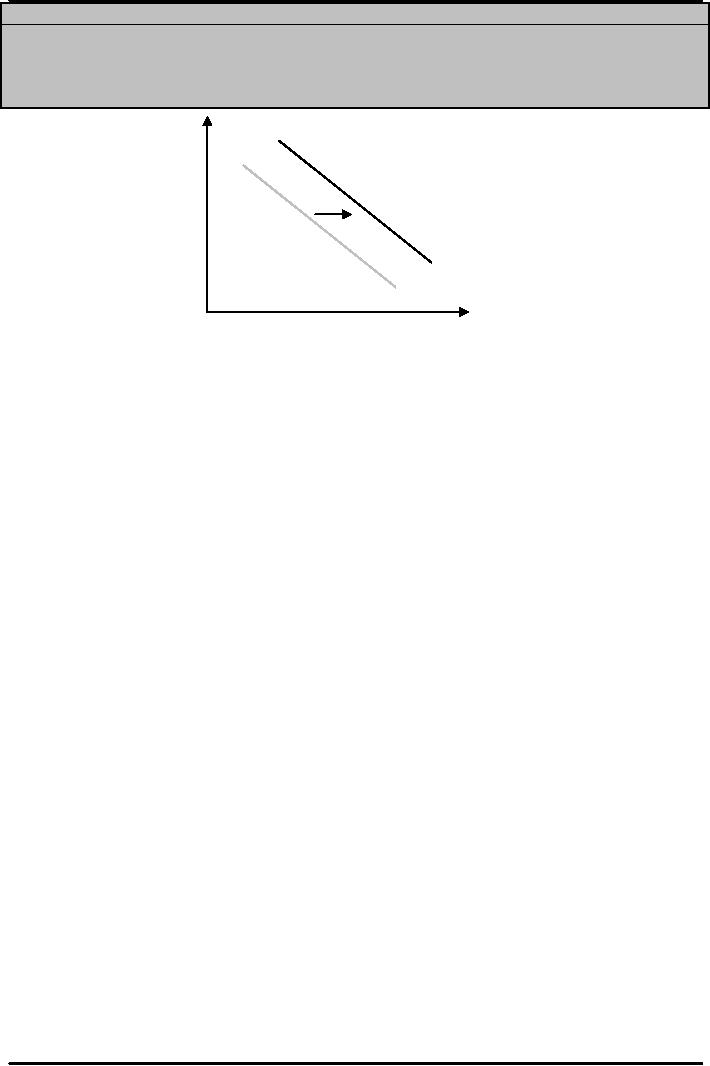 |
THE AGGREGATE DEMAND CURVE:Shifting the Aggregate Demand Curve |
| << DERIVING THE MONETARY POLICY REACTION CURVE |
| THE AGGREGATE SUPPLY CURVE:Inflation Shocks >> |

Money
& Banking MGT411
VU
Lesson
42
THE
AGGREGATE DEMAND
CURVE
The
slope of the aggregate demand curve
tells us how sensitive current
output is to a given
change
in current inflation.
The
aggregate demand curve will
be relatively
Flat
if current output is very sensitive to
inflation (a change in current
inflation causes a
large
movement
in current output)
Steep
if current output is not
very sensitive to inflation
Three
factors influence the sensitivity of
current output to
inflation:
The
strength of the effect of inflation on
real money balances,
The
extent to which monetary
policymakers react to a change in
current inflation,
The
size of the response of aggregate
demand to changes in the interest
rate
The
second factor relates to the slope of the
monetary policy reaction
curve
If
policymakers react aggressively to a
movement of current inflation away
from its target
level
with
a large change in the real interest rate,
the monetary policy reaction
curve will be steep
and
the
aggregate demand curve is
flat
If
policymakers respond more cautiously, the
monetary policy reaction
curve is flat and the
aggregate
demand curve is steep
The
slope of the aggregate demand curve
depends in part on the preferences of
the central bank;
how
aggressive policymakers are in
responding to deviations of inflation
from the target level
There
are two reasons why the
aggregate demand curve
slopes down:
First,
because higher inflation
reduces real money balances
(thus reducing purchases),
Second,
because higher inflation
induces policymakers to raise the
real interest rate, depressing
various
components of aggregate
demand
Rising
inflation also reduces
wealth, which lowers
consumption and drives down
aggregate
demand.
In
addition, as inflation rises the
uncertainty about inflation
rises, which makes equities
a more
risky
investment and drops their value,
also reducing wealth
Another
reason is that inflation can
have a greater impact on the poor than it
does on the
wealthy,
redistributing income to those who
are better off
People
may also save more as a
result of the increased risk
associated with
inflation.
Also,
rising inflation makes
foreign goods cheaper in
relation to domestic goods,
driving
imports
up and net exports
down.
Shifting
the Aggregate Demand Curve
In
our derivation of the aggregate
demand curve, we held
constant both the location of
the
monetary
policy reaction curve and
those components of aggregate
demand that do not
respond
to
the real interest rate.
Changes
in any of those components, as
well as changes in the location of the
monetary policy
reaction
curve, will shift the
aggregate demand
curve.
Shifts
in the Monetary Policy Reaction
Curve
Whenever
the monetary policy reaction
curve shifts, the aggregate demand
curve will shift as
well
Changes
in the long-run real interest rate, which
is a consequence of the structure of the
economy,
will also shift aggregate
demand
133

Money
& Banking MGT411
VU
Figure:
Shifting the Aggregate Demand Curve
(ADC)
Increases
in aggregate Demand arising
from a change in monetary policy,
such as a higher
inflation
target, will shift the
aggregate demand curve to the
right. Increases in interest rate
intensive
components of aggregate demand, such as
government purchases, will also shift
the
aggregate
demand curve to the
right.
Inflation
(�)
New
ADC
Old
ADC
Output
(Y)
Either
a fall in target inflation or a rise in
the long-run real interest rate will
shift the monetary
policy
reaction curve to the left and the
aggregate demand curve to the
left.
Changes
in the Components of Aggregate
Demand
Any
change in a component of aggregate demand
that is caused by a factor
other than a change
in
the real interest rate will shift the
aggregate demand
curve.
When
firms become more optimistic
about the future, or consumer
confidence increases,
investment
or consumption will increase and
aggregate demand will shift
to the right.
Changes
in the Components of Aggregate
Demand
Increases
in government purchases will
increase aggregate demand, as
will decreases in
taxes.
Increases
in net exports that are unrelated to
changes in real interest rates
will shift the
aggregate
demand curve to the
right
Changes
that shift the Components of Aggregate
Demand to the
right:
An
increase in consumption that is
unrelated to a change in the real
interest rate.
An
increase in investment that is
unrelated to a change in the real
interest rate.
An
increase in government
purchases
A
decrease in taxes
An
increase in net exports that is unrelated
to a change in the real interest
rate
Because
shifts in the monetary policy
reaction curve can shift the
aggregate demand curve, it
is
possible
that monetary policy can
cause recessions.
If
policymakers can cause
recessions, they can
probably avoid them as well by
neutralizing
shifts
in aggregate demand that
arise from other
sources.
The
analysis up to this point has
assumed that inflation does
not change over time;
but in reality
Inflation
and output are jointly
determined, and monetary policy
plays a role in the
short-run
Movements
of both.
134
Table of Contents:
- TEXT AND REFERENCE MATERIAL & FIVE PARTS OF THE FINANCIAL SYSTEM
- FIVE CORE PRINCIPLES OF MONEY AND BANKING:Time has Value
- MONEY & THE PAYMENT SYSTEM:Distinctions among Money, Wealth, and Income
- OTHER FORMS OF PAYMENTS:Electronic Funds Transfer, E-money
- FINANCIAL INTERMEDIARIES:Indirect Finance, Financial and Economic Development
- FINANCIAL INSTRUMENTS & FINANCIAL MARKETS:Primarily Stores of Value
- FINANCIAL INSTITUTIONS:The structure of the financial industry
- TIME VALUE OF MONEY:Future Value, Present Value
- APPLICATION OF PRESENT VALUE CONCEPTS:Compound Annual Rates
- BOND PRICING & RISK:Valuing the Principal Payment, Risk
- MEASURING RISK:Variance, Standard Deviation, Value at Risk, Risk Aversion
- EVALUATING RISK:Deciding if a risk is worth taking, Sources of Risk
- BONDS & BONDS PRICING:Zero-Coupon Bonds, Fixed Payment Loans
- YIELD TO MATURIRY:Current Yield, Holding Period Returns
- SHIFTS IN EQUILIBRIUM IN THE BOND MARKET & RISK
- BONDS & SOURCES OF BOND RISK:Inflation Risk, Bond Ratings
- TAX EFFECT & TERM STRUCTURE OF INTEREST RATE:Expectations Hypothesis
- THE LIQUIDITY PREMIUM THEORY:Essential Characteristics of Common Stock
- VALUING STOCKS:Fundamental Value and the Dividend-Discount Model
- RISK AND VALUE OF STOCKS:The Theory of Efficient Markets
- ROLE OF FINANCIAL INTERMEDIARIES:Pooling Savings
- ROLE OF FINANCIAL INTERMEDIARIES (CONTINUED):Providing Liquidity
- BANKING:The Balance Sheet of Commercial Banks, Assets: Uses of Funds
- BALANCE SHEET OF COMMERCIAL BANKS:Bank Capital and Profitability
- BANK RISK:Liquidity Risk, Credit Risk, Interest-Rate Risk
- INTEREST RATE RISK:Trading Risk, Other Risks, The Globalization of Banking
- NON- DEPOSITORY INSTITUTIONS:Insurance Companies, Securities Firms
- SECURITIES FIRMS (Continued):Finance Companies, Banking Crisis
- THE GOVERNMENT SAFETY NET:Supervision and Examination
- THE GOVERNMENT'S BANK:The Bankers' Bank, Low, Stable Inflation
- LOW, STABLE INFLATION:High, Stable Real Growth
- MEETING THE CHALLENGE: CREATING A SUCCESSFUL CENTRAL BANK
- THE MONETARY BASE:Changing the Size and Composition of the Balance Sheet
- DEPOSIT CREATION IN A SINGLE BANK:Types of Reserves
- MONEY MULTIPLIER:The Quantity of Money (M) Depends on
- TARGET FEDERAL FUNDS RATE AND OPEN MARKET OPERATION
- WHY DO WE CARE ABOUT MONETARY AGGREGATES?The Facts about Velocity
- THE FACTS ABOUT VELOCITY:Money Growth + Velocity Growth = Inflation + Real Growth
- THE PORTFOLIO DEMAND FOR MONEY:Output and Inflation in the Long Run
- MONEY GROWTH, INFLATION, AND AGGREGATE DEMAND
- DERIVING THE MONETARY POLICY REACTION CURVE
- THE AGGREGATE DEMAND CURVE:Shifting the Aggregate Demand Curve
- THE AGGREGATE SUPPLY CURVE:Inflation Shocks
- EQUILIBRIUM AND THE DETERMINATION OF OUTPUT AND INFLATION
- SHIFTS IN POTENTIAL OUTPUT AND REAL BUSINESS CYCLE THEORY